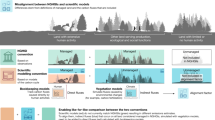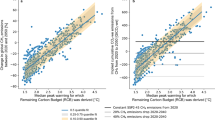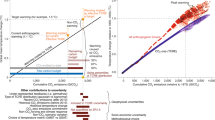Abstract
Commitments to net-zero carbon dioxide (CO2) or greenhouse gas (GHG) emissions targets now cover 88% of countries’ emissions. Underlying the accounting behind net-zero frameworks is the assumption that emissions can be balanced with removals such that their net climate effect is zero. However, when considering the full climate impacts of CO2 emissions and removals, there are reasons to expect that the two are not equivalent in terms of their climate outcomes. We identify potential contributors to non-equivalence, including impermanence, biogeophysical and non-CO2 GHG effects, and argue that these non-equivalencies need to be accounted for to achieve climate goals. Given key uncertainties about the full climate impact of CO2 removal, it is prudent to prioritize emission reductions over removals.
This is a preview of subscription content, access via your institution
Access options
Access Nature and 54 other Nature Portfolio journals
Get Nature+, our best-value online-access subscription
$29.99 / 30 days
cancel any time
Subscribe to this journal
Receive 12 print issues and online access
$209.00 per year
only $17.42 per issue
Buy this article
- Purchase on Springer Link
- Instant access to full article PDF
Prices may be subject to local taxes which are calculated during checkout



Similar content being viewed by others
References
Rogelj, J., Geden, O., Cowie, A. & Reisinger, A. Three ways to improve net-zero emissions targets. Nature 591, 365–368 (2021).
Lang, J. et al. Net Zero Tracker (Energy and Climate Intelligence Unit, Data-Driven EnviroLab, NewClimate Institute, Oxford Net Zero, 2023).
IPCC Special Report on Global Warming of 1.5 °C (eds Masson-Delmotte, V. et al.) (WMO, 2018).
Canadell, J. G. et al. in Climate Change 2021: The Physical Science Basis (eds Masson-Delmotte, V. et al.) 673–816 (IPCC, Cambridge Univ. Press, 2021).
Solomon, S., Plattner, G.-K., Knutti, R. & Friedlingstein, P. Irreversible climate change due to carbon dioxide emissions. Proc. Natl Acad. Sci. USA 106, 1704–1709 (2009).
Eby, M. et al. Lifetime of anthropogenic climate change: millennial time scales of potential CO2 and temperature perturbations. J. Clim. 22, 2501–2511 (2009).
Betts, R. A. Offset of the potential carbon sink from boreal forestation by decreases in surface albedo. Nature 408, 187–190 (2000).
Jackson, R. B. et al. Protecting climate with forests. Environ. Res. Lett. 3, 044006 (2008).
Arora, V. K. & Montenegro, A. Small temperature benefits provided by realistic afforestation efforts. Nat. Geosci. 4, 514–518 (2011).
Bright, R. M. et al. Local temperature response to land cover and management change driven by non-radiative processes. Nat. Clim. Change 7, 296–302 (2017).
Windisch, M. G., Davin, E. L. & Seneviratne, S. I. Prioritizing forestation based on biogeochemical and local biogeophysical impacts. Nat. Clim. Change 11, 867–871 (2021).
Benanti, G., Saunders, M., Tobin, B. & Osborne, B. Contrasting impacts of afforestation on nitrous oxide and methane emissions. Agric. For. Meteorol. 198–199, 82–93 (2014).
Dou, X., Zhou, W., Zhang, Q. & Cheng, X. Greenhouse gas (CO2, CH4, N2O) emissions from soils following afforestation in central China. Atmos. Environ. 126, 98–106 (2016).
Chen, P. et al. Effects of afforestation on soil CH4 and N2O fluxes in a nsubtropical karst landscape. Sci. Total Environ. 705, 135974 (2020).
McDaniel, M. D., Saha, D., Dumont, M. G., Hernández, M. & Adams, M. A. The effect of land-use change on soil CH4 and N2O fluxes: a global meta-analysis. Ecosystems 22, 1424–1443 (2019).
Unger, N. Human land-use-driven reduction of forest volatiles cools global climate. Nat. Clim. Change 4, 907–910 (2014).
Scott, C. E. et al. Impact on short-lived climate forcers increases projected warming due to deforestation. Nat. Commun. 9, 157 (2018).
Richards, K. R. & Huebner, G. E. Evaluating protocols and standards for forest carbon-offset programs, part A: additionality, baselines and permanence. Carbon Manag. 3, 393–410 (2012).
Richards, K. R. & Huebner, G. E. Evaluating protocols and standards for forest carbon-offset programs, part B: leakage assessment, wood products, validation and verification. Carbon Manag. 3, 411–425 (2012).
Nolan, C. J., Field, C. B. & Mach, K. J. Constraints and enablers for increasing carbon storage in the terrestrial biosphere. Nat. Rev. Earth Environ. 2, 436–446 (2021).
Matthews, H. D. & Caldeira, K. Stabilizing climate requires near-zero emissions. Geophys. Res. Lett. 35, L04705 (2008).
Zickfeld, K. et al. Long-term climate change commitment and reversibility: an EMIC intercomparison. J. Clim. 26, 5782–5809 (2013).
MacDougall, A. H. et al. Is there warming in the pipeline? A multi-model analysis of the Zero Emissions Commitment from CO2. Biogeosciences 17, 2987–3016 (2020).
Anderegg, W. R. L. et al. Climate-driven risks to the climate mitigation potential of forests. Science https://doi.org/10.1126/science.aaz7005 (2020).
A Research Strategy for Ocean-Based Carbon Dioxide Removal and Sequestration (National Academies, 2021).
Babiker, M. et al. in Climate Change 2022: Mitigation of Climate Change (eds Shukla, P. R. et al.) 1245–1354 (IPCC, Cambridge Univ. Press, 2022).
van Mantgem, P. J. et al. Widespread increase of tree mortality rates in the western United States. Science 323, 521–524 (2009).
Allen, C. D. et al. A global overview of drought and heat-induced tree mortality reveals emerging climate change risks for forests. Ecol. Manag. 259, 660–684 (2010).
Seidl, R. et al. Forest disturbances under climate change. Nat. Clim. Change 7, 395–402 (2017).
Senf, C. et al. Canopy mortality has doubled in Europe’s temperate forests over the last three decades. Nat. Commun. 9, 4978 (2018).
Canadell, J. G. et al. Multi-decadal increase of forest burned area in Australia is linked to climate change. Nat. Commun. 12, 6921 (2021).
Fan, L. et al. Siberian carbon sink reduced by forest disturbances. Nat. Geosci. 16, 56–62 (2023).
Zheng, B. et al. Record-high CO2 emissions from boreal fires in 2021. Science 379, 912–917 (2023).
Canadell, J. G. & Jackson, R. B. Ecosystem Collapse and Climate Change (Springer Nature, 2021).
Minx, J. C. et al. Negative emissions - part 1: research landscape and synthesis. Environ. Res. Lett. 13, 063001 (2018).
Alcalde, J. et al. Estimating geological CO2 storage security to deliver on climate mitigation. Nat. Commun. 9, 2201 (2018).
Hepburn, C. et al. The technological and economic prospects for CO2 utilization and removal. Nature 575, 87–97 (2019).
Matthews, H. D. et al. Temporary nature-based carbon removal can lower peak warming in a well-below 2 °C scenario. Commun. Earth Environ. 3, 65 (2022).
Bonan, G. B. Forests and climate change: forcings, feedbacks, and the climate benefits of forests. Science 320, 1444–1449 (2008).
Cerasoli, S., Yin, J. & Porporato, A. Cloud cooling effects of afforestation and reforestation at midlatitudes. Proc. Natl Acad. Sci. USA 118, e2026241118 (2021).
Duveiller, G. et al. Revealing the widespread potential of forests to increase low level cloud cover. Nat. Commun. 12, 4337 (2021).
Mykleby, P. M., Snyder, P. K. & Twine, T. E. Quantifying the trade-off between carbon sequestration and albedo in midlatitude and high-latitude North American forests. Geophys. Res. Lett. 44, 2493–2501 (2017).
Winckler, J., Lejeune, Q., Reick, C. H. & Pongratz, J. Nonlocal effects dominate the global mean surface temperature response to the biogeophysical effects of deforestation. Geophys. Res. Lett. 46, 745–755 (2019).
De Hertog, S. J. et al. The biogeophysical effects of idealized land cover and land management changes in Earth system models. Earth Syst. Dynam. 14, 629–667 (2023).
Georgescu, M., Lobell, D. B. & Field, C. B. Direct climate effects of perennial bioenergy crops in the United States. Proc. Natl Acad. Sci. USA 108, 4307–4312 (2011).
Wang, J. et al. Global cooling induced by biophysical effects of bioenergy crop cultivation. Nat. Commun. 12, 7255 (2021).
Hirsch, A. L. et al. Biogeophysical impacts of land-use change on climate extremes in low-emission scenarios: results from HAPPI-Land. Earth Future 6, 396–409 (2018).
Lugato, E., Leip, A. & Jones, A. Mitigation potential of soil carbon management overestimated by neglecting N2O emissions. Nat. Clim. Change 8, 219–223 (2018).
Davin, E. L., Seneviratne, S. I., Ciais, P., Olioso, A. & Wang, T. Preferential cooling of hot extremes from cropland albedo management. Proc. Natl Acad. Sci. USA 111, 9757–9761 (2014).
Genesio, L. et al. Surface albedo following biochar application in durum wheat. Environ. Res. Lett. 7, 014025 (2012).
Zhang, Y. et al. Response of surface albedo and soil carbon dioxide fluxes to biochar amendment in farmland. J. Soils Sediment. 18, 1590–1601 (2018).
Negative Emissions Technologies and Reliable Sequestration: A Research Agenda (National Academies, 2018).
Oschlies, A. Climate engineering by artificial ocean upwelling: channelling the sorcerer’s apprentice. Geophys. Res. Lett. 37, L04701 (2010).
Keller, D. P., Feng, E. Y. & Oschlies, A. Potential climate engineering effectiveness and side effects during a high carbon dioxide-emission scenario. Nat. Commun. 5, 3304 (2014).
Mei, K. et al. Stimulation of N2O emission by conservation tillage management in agricultural lands: a meta-analysis. Soil Tillage Res. 182, 86–93 (2018).
Guenet, B. et al. Can N2O emissions offset the benefits from soil organic carbon storage? Glob. Change Biol. 27, 237–256 (2021).
Jeffery, S., Verheijen, F. G. A., Kammann, C. & Abalos, D. Biochar effects on methane emissions from soils: a meta-analysis. Soil Biol. Biochem. 101, 251–258 (2016).
Huang, Y. et al. Methane and nitrous oxide flux after biochar application in subtropical acidic paddy soils under tobacco-rice rotation. Sci. Rep. 9, 17277 (2019).
Cayuela, M. L. et al. Biochar’s role in mitigating soil nitrous oxide emissions: a review and meta-analysis. Agric. Ecosyst. Environ. 191, 5–16 (2014).
Kammann, C. et al. Biochar as a tool to teduce the agricultural greenhouse-gas burden – knowns, unknowns and future research needs. J. Environ. Eng. Landsc. Manag. 25, 114–139 (2017).
Paustian, K., Larson, E., Kent, J., Marx, E. & Swan, A. Soil C sequestration as a biological negative emission strategy. Front. Clim. 1, 8 (2019).
Law, C. S. & Ling, R. D. Nitrous oxide flux and response to increased iron availability in the Antarctic Circumpolar Current. Deep Sea Res. Pt II 48, 2509–2527 (2001).
Oschlies, A., Koeve, W., Rickels, W. & Rehdanz, K. Side effects and accounting aspects of hypothetical large-scale Southern Ocean iron fertilization. Biogeosciences 7, 4017–4035 (2010).
Oreska, M. P. J. et al. The greenhouse gas offset potential from seagrass restoration. Sci. Rep. 10, 7325 (2020).
Creutzig, F. et al. The mutual dependence of negative emission technologies and energy systems. Energy Environ. Sci. 12, 1805–1817 (2019).
Boucher, O. et al. Reversibility in an Earth System model in response to CO2 concentration changes. Env. Res. Lett. 7, 24013 (2012).
Zickfeld, K., MacDougall, A. H. & Matthews, H. D. On the proportionality between global temperature change and cumulative CO2 emissions during periods of net negative CO2 emissions. Environ. Res. Lett. 11, 055006 (2016).
Koven, C. D., Sanderson, B. M. & Swann, A. L. S. Much of zero emissions commitment occurs before reaching net zero emissions. Environ. Res. Lett. 18, 14017 (2023).
Zickfeld, K., Azevedo, D., Mathesius, S. & Matthews, H. D. Asymmetry in the climate-carbon cycle response to positive and negative CO2 emissions. Nat. Clim. Change 11, 613–617 (2021).
Walker, A. P. et al. Integrating the evidence for a terrestrial carbon sink caused by increasing atmospheric CO2. N. Phytol. 229, 2413–2445 (2021).
Sarmiento, J. L., Le Quéré, C. & Pacala, S. W. Limiting future atmospheric carbon dioxide. Glob. Biogeochem. Cycles 9, 121–137 (1995).
Compliance Offset Protocol U.S. Forest Projects (California Environmental Protection Agency, California Air Resources Board, 2015).
McDowell, N. G. et al. Pervasive shifts in forest dynamics in a changing world. Science 368, eaaz9463 (2020).
Ruseva, T. et al. Rethinking standards of permanence for terrestrial and coastal carbon: implications for governance and sustainability. Curr. Opin. Environ. Sustain. 45, 69–77 (2020).
Walker, W. S. et al. The role of forest conversion, degradation, and disturbance in the carbon dynamics of Amazon indigenous territories and protected areas. Proc. Natl Acad. Sci. USA 117, 3015–3025 (2020).
Parisa, Z., Marland, E., Sohngen, B., Marland, G. & Jenkins, J. The time value of carbon storage. For. Policy Econ. 144, 102840 (2022).
Kirschbaum, M. U. F. Temporary carbon sequestration cannot prevent climate change. Mitig. Adapt. Strateg. Glob. Change 11, 1151–1164 (2006).
Chay, F. et al. Unpacking ton-year accounting. Carbon Plan https://carbonplan.org/research/ton-year-explainer (2022).
Fankhauser, S. et al. The meaning of net zero and how to get it right. Nat. Clim. Change 12, 15–21 (2022).
Allen, M. R. et al. Net zero: science, origins, and implications. Annu. Rev. Environ. Resour. 47, 849–887 (2022).
Griscom, B. W. et al. Natural climate solutions. Proc. Natl Acad. Sci. USA 114, 11645–11650 (2017).
Matthews, H. D., Zickfeld, K., Koch, A. & Luers, A. Accounting for the climate benefit of temporary carbon storage in nature. Nat. Commun. 14, 5485 (2023).
Bright, R. M., Bogren, W., Bernier, P. & Astrup, R. Carbon-equivalent metrics for albedo changes in land management contexts: relevance of the time dimension. Ecol. Appl. 26, 1868–1880 (2016).
Drever, C. R. et al. Natural climate solutions for Canada. Sci. Adv. 7, eabd6034 (2022).
Peng, S.-S. et al. Afforestation in China cools local land surface temperature. Proc. Natl Acad. Sci. USA 111, 2915–2919 (2014).
Gattuso, J.-P., Williamson, P., Duarte, C. M. & Magnan, A. K. The potential for ocean-based climate action: negative emissions technologies and beyond. Front. Clim. 2, 2020 (2021).
Szopa, S. et al. in Climate Change 2021: The Physical Science Basis (eds Masson-Delmotte, V. et al.) 817–922 (IPCC, Cambridge Univ. Press, 2021).
Allen, M. R. et al. New use of global warming potentials to compare cumulative and short-lived climate pollutants. Nat. Clim. Change 6, 773–776 (2016).
Rogelj, J. & Schleussner, C.-F. Unintentional unfairness when applying new greenhouse gas emissions metrics at country level. Environ. Res. Lett. 14, 114039 (2019).
Collins, W. J., Frame, D. J., Fuglestvedt, J. S. & Shine, K. P. Stable climate metrics for emissions of short and long-lived species—combining steps and pulses. Environ. Res. Lett. 15, 24018 (2020).
Folberth, G. A. et al. Description and evaluation of an emission-driven and fully coupled methane cycle in UKESM1. J. Adv. Model. Earth Syst. 14, e2021MS002982 (2022).
Nzotungicimpaye, C.-M. et al. WETMETH 1.0: a new wetland methane model for implementation in Earth system models. Geosci. Model Dev. 14, 6215–6240 (2021).
IPCC: Summary for Policymakers. In Climate Change 2021: The Physical Science Basis (eds Masson-Delmotte, V. et al.) 3−32 (Cambridge Univ. Press, 2021).
Matthews, J. B. R. et al. in Climate Change 2021: The Physical Science Basis (eds Masson-Delmotte, V. et al.) 2215–2256 (IPCC, Cambridge Univ. Press, 2021).
Mengis, N. et al. Evaluation of the University of Victoria Earth System Climate Model version 2.10 (UVic ESCM 2.10). Geosci. Model Dev. 13, 4183–4204 (2020).
Adoption of the Paris Agreement FCCC/CP/2015/L.9/Rev/1 (UNFCCC, 2015).
Acknowledgements
K.Z., A.J.M. and H.D.M. acknowledge support from the Natural Sciences and Engineering Research Council of Canada’s Discovery Grant Program (grant numbers RGPIN-2018-06881 and RGPIN-2017-04159) and the Government of Canada’s Climate Action and Awareness Fund (grant number 1000497419). J.G.C. thanks the Australian National Environmental Science Program Climate Systems Hub for support. R.B.J. acknowledges support from the U.N. Environment Programme. C.D.J. was supported by the Joint UK BEIS/Defra Met Office Hadley Centre Climate Programme (grant number GA01101). C.D.J., J.R. and S.Z. were supported by the European Union’s Horizon 2020 research and innovation programme under grant agreement number 101003536 (ESM2025—Earth System Models for the Future). G.P.P. and S.Z. were supported by the European Union’s Horizon 2020 research and innovation programme under grant agreement number 821003 (4C—Climate-Carbon Interactions in the Current Century). A.L. was supported by the ACCC Flagship funded by the Academy of Finland (grant numbers 337549 and 337552 from the University of Helsinki and Finnish Meteorological Institute, respectively).
Ethics declarations
Competing interests
The authors declare no competing interests.
Peer review
Peer review information
Nature Climate Change thanks Michael Windisch and the other, anonymous, reviewer(s) for their contribution to the peer review of this work.
Additional information
Publisher’s note Springer Nature remains neutral with regard to jurisdictional claims in published maps and institutional affiliations.
Supplementary information
Supplementary Information
Supplementary Methods.
Source data
Source Data Fig. 3
Climate model data.
Rights and permissions
Springer Nature or its licensor (e.g. a society or other partner) holds exclusive rights to this article under a publishing agreement with the author(s) or other rightsholder(s); author self-archiving of the accepted manuscript version of this article is solely governed by the terms of such publishing agreement and applicable law.
About this article
Cite this article
Zickfeld, K., MacIsaac, A.J., Canadell, J.G. et al. Net-zero approaches must consider Earth system impacts to achieve climate goals. Nat. Clim. Chang. 13, 1298–1305 (2023). https://doi.org/10.1038/s41558-023-01862-7
Received:
Accepted:
Published:
Issue Date:
DOI: https://doi.org/10.1038/s41558-023-01862-7



